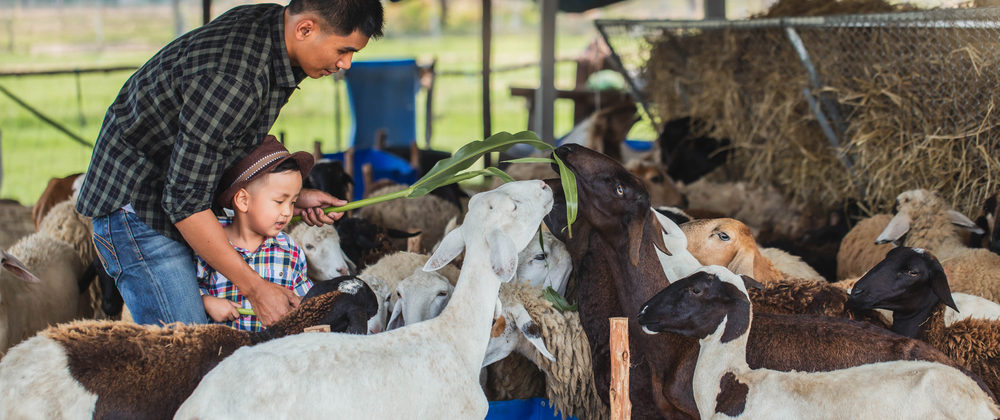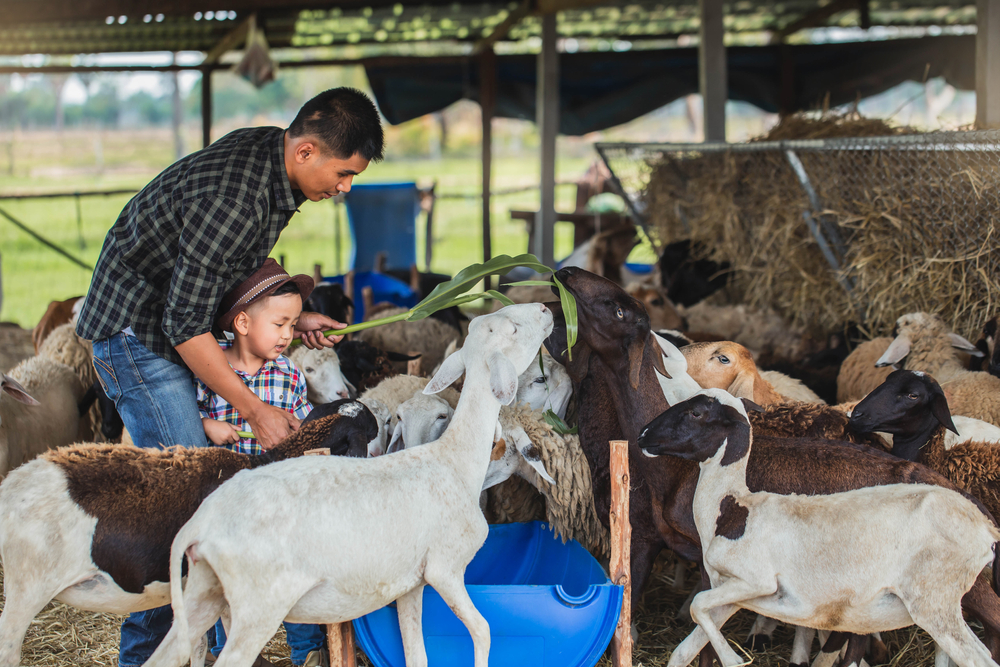Bartonella species are bacteria present in wild and domesticated animal populations throughout the world. It is important to be aware of the breadth of Bartonella species, including those associated with cows, sheep, deer, and other ruminants, because of their potential role in both animal and human disease.
Research on the Bartonella genus over the past 30 years has resulted in the discovery of over 40 species, each associated with a specific group of animals and often transmitted by various arthropod vectors. About half of the characterized Bartonella species have been identified as zoonotic, or transmissible to humans, highlighting the importance of understanding the prevalence and pathogenicity of each.
A large amount of research is focused on companion animals, like dogs and cats, but what about ruminants?
What are ruminants?
Ruminants are a group of animals named for the rumen, which is a specialized chamber located at the beginning of their GI tract. The rumen is home to a diverse population of commensal microbes that produce extracellular enzymes capable of breaking down the fibers in forage (grass, hay) into fatty acids that are then used by the animal cells for energy metabolism. Grazing mammals, such as cattle, sheep, deer, yak, and more require the rumen to effectively digest their food.
Occupations and/or living situations that require interacting with ruminants daily may put people at a higher risk for bartonellosis. For example, farmers or ranchers are constantly spending time caring for their livestock, and large-animal veterinarians will make routine trips to farms to provide care.
Studies estimate that the prevalence of Bartonella species bacteremia among select ruminant populations can range from 50-95% on average, but bacteremia is rarely implicated in cases of animal or human disease.
Bartonella bovis, Bartonella melophagi, and more
Cattle, yak, buffaloes, and other bovids are the reservoir hosts for Bartonella bovis. The global prevalence of B. bovis varies, with one study showing bacteremia as low as 10% in cattle and buffalo populations across five countries. Likewise, a study focused on beef cattle located in North Carolina found that 82% were infected. There could be many reasons for this disparity, but one possibility is whether there are competent vectors for B. bovis within the geographic region.
Unlike companion animals whose flea transmission of Bartonella is known, cattle populations are less likely to have flea infestations. This means that there are other vectors keeping B. bovis circulating within a population. Like the prevalence in bovids themselves, there are variations in the prevalence of B. bovis in their associated vectors, such as louse flies (keds), ticks, and lice. A recent study of dairy cattle in Algeria found that B. bovis was present in 78% of keds, whereas only 7% of ticks had Bartonella DNA present. In a similar study of cattle and yak located in Brazil, about 10% of ticks were infected. It is difficult to know which vectors are responsible for transmission without more research establishing competency, but it is likely that multiple vectors exist.
Bartonella melophagi is associated with sheep, deer, and other cervid populations throughout the world. The prevalence of B. melophagi seems to vary depending on the geographic region and host population in question, similar to B. bovis. A 2016 study found that 89% of sheep located in the Southwestern United States were positive, whereas only 16% of deer in the Southeastern United States tested positive for Bartonella species in a 2020 study.
Sheep keds (Melophagus ovinus) seem to be the primary vector of Bartonella melophagi in sheep based on current research. In one study, it was found that at least one of the keds removed from each bacteremic sheep in Ethiopia tested positive for B. melophagi DNA. Keds are responsible for transmitting other diseases between sheep, such as Anaplasma ovis and blue tongue virus, so it is likely that they transmit Bartonella species as well.
Additional Bartonella species that have been associated with ruminants include B. chomelii, B. schoenbuchensis, and B. ovis.
Clinical Importance
Ruminant Bartonella species are rarely implicated in human or animal bartonellosis, but case reports suggest it is possible for them to cause disease that is comparable to other Bartonella species pathology. A 2007 publication describes B. bovis causing endocarditis in cattle in France. B. henselae and B. quintana are known causative agents of culture-negative endocarditis in both people and pets, leading to the suspicion that B. bovis can have similar clinical effects.
B. melophagi is the only ruminant Bartonella species to date that has been isolated from a person. A case report from 2009 describes North Carolina State University researchers using PCR and BAPGM enrichment to detect the sheep-related species in the blood of two symptomatic women. The first woman reported cyclical symptoms that progressively worsened. She had minimal animal exposure but did report bites from fleas and other insects. Likewise, the second woman was exposed to many animals including cats, dogs, emu, llamas, and more due to her involvement in their care. Before B. melophagi was detected in her blood, she was diagnosed with pericarditis of unknown etiology.
Conclusion
The Bartonella genus represents a diverse group of bacteria that can be found across many groups of animals and negatively affects the health of its hosts in some cases. Ruminant Bartonella species, such as B. bovis and B. melophagi, have rarely been associated with disease but require further research to understand their roles in human and animal disease.
References
Chang, C. C. et al. (2000). Bartonella spp. isolated from wild and domestic ruminants in North America. Emerging Infectious Diseases, 6(3), 306-311. 10.3201/eid0603.000313 https://www.ncbi.nlm.nih.gov/pmc/articles/PMC2640866/
Raya, A. P. et al. (2018). Detection of Bartonella species, including Candidatus Bartonella ovis sp. nov, in ruminants from Mexico and lack of evidence of Bartonella DNA in saliva of common vampire bats (Desmodus rotundus) predating on them Veterinary Microbiology, 222, 69-74. https://doi.org/10.1016/j.vetmic.2018.06.018 https://www.sciencedirect.com/science/article/pii/S0378113518306011
Kosoy, M. et al. (2016). Bartonella melophagi in blood of domestic sheep (Ovis aries) and sheep keds (Melophagus ovinus) from the southwestern US: Cultures, genetic characterization, and ecological connections. Veterinary Microbiology, 190, 43-49. https://doi.org/10.1016/j.vetmic.2016.05.009 https://www.sciencedirect.com/science/article/pii/S0378113516301262 – B. melophagi and sheep keds in United States
Kumsa, B. et al. (2014). Bartonella melophagi in Melophagus ovinus (sheep ked) collected from sheep in northern Oromia, Ethiopia. Comparative Immunology, Microbiology and Infectious Diseases, 37(1), 69-76. https://doi.org/10.1016/j.cimid.2013.11.001 https://www.sciencedirect.com/science/article/abs/pii/S0147957113000945 – B. melophagi in Ethiopian sheep
Boularias, G. (2020). Bartonella bovis and Bartonella chomelii infection in dairy cattle and their ectoparasites in Algeria. Comparative Immunology, Microbiology and Infectious Diseases, 70(1), 101450. https://doi.org/10.1016/j.cimid.2020.101450 https://www.sciencedirect.com/science/article/abs/pii/S0147957120300394 – B. bovis
Maggi, R. G. et al. (2009). Isolation of Candidatus Bartonella melophagi from human blood. Emerging Infectious Diseases, 15(1), 66-68. 10.3201/eid1501.081080 https://wwwnc.cdc.gov/eid/article/15/1/08-1080_article – B. melophagi in 2 women
Maillard, R. et al. (2007). Endocarditis in cattle caused by Bartonella bovis. Emerging Infectious Diseases, 13(9), 1383. 10.3201/eid1309.070236 https://wwwnc.cdc.gov/eid/article/13/9/07-0236_article
Weintraub, P. (2009). Bartonella: It infects sheep, now humans [blog post]. Available at: https://www.psychologytoday.com/us/blog/emerging-diseases/200901/bartonella-it-infects-sheep-now-humans
Breitschwerdt, E. B., & Kordick, D. L. (2000). Bartonella infection in animals: Carriership, reservoir potential, pathogenicity, and zoonotic potential for human infection. Clinical Microbiology Reviews, 13(3), 428-438. 10.1128/CMR.13.3.428 https://cmr.asm.org/content/13/3/428
Gonçalves, L. R. et al. (2020). Molecular detection and genetic diversity of Bartonella species in large ruminants and associated ectoparasites from the Brazilian Cerrado [online early view]. Transboundary and Emerging Diseases. https://doi.org/10.1111/tbed.13517 https://onlinelibrary.wiley.com/doi/abs/10.1111/tbed.13517
Izenour, K. et al. (2020). Diverse Bartonella spp. detected in white-tailed deer (Odocoileus virginianus) and associated keds (Lipoptena mazamae) in the Southeastern USA. Journal of Wildlife Diseases, 56(3), 505-511. https://doi.org/10.7589/2019-08-196 https://www.jwildlifedis.org/doi/abs/10.7589/2019-08-196
Aguirre, E. A. et al. (2020). Melophagus ovinus a relevant vector in the transmission of diseases [online version]. Revista Electrόnica Nueva Época Veterinaria https://www.researchgate.net/publication/339337749_Melophagus_ovinus_A_RELEVANT_VECTOR_IN_THE_TRANSMISSION_OF_DISEASES



